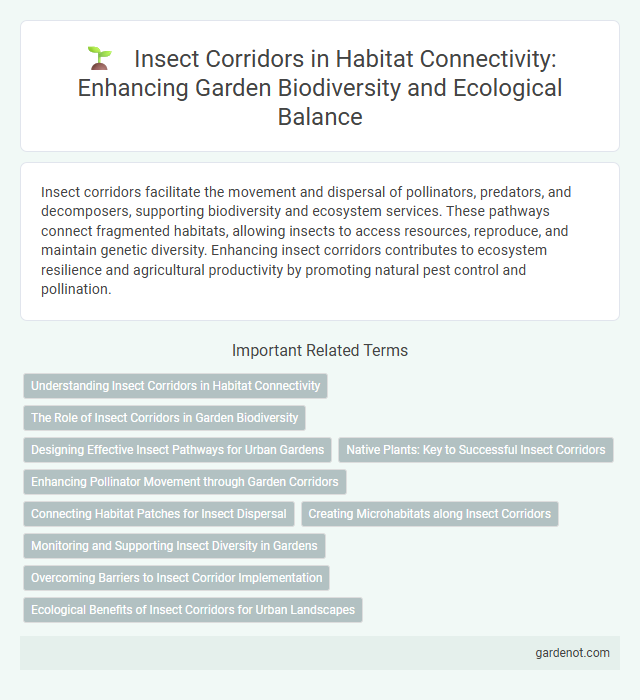Insect corridors facilitate the movement and dispersal of pollinators, predators, and decomposers, supporting biodiversity and ecosystem services. These pathways connect fragmented habitats, allowing insects to access resources, reproduce, and maintain genetic diversity. Enhancing insect corridors contributes to ecosystem resilience and agricultural productivity by promoting natural pest control and pollination.
Understanding Insect Corridors in Habitat Connectivity
Insect corridors play a crucial role in maintaining habitat connectivity by facilitating the movement and dispersal of pollinators, decomposers, and other essential invertebrates across fragmented landscapes. These corridors enhance genetic diversity, support ecosystem services, and improve resilience against environmental changes by linking isolated insect populations. Effective design of insect corridors incorporates native vegetation, microhabitat diversity, and continuous habitat patches to optimize species-specific movement and survival.
The Role of Insect Corridors in Garden Biodiversity
Insect corridors play a crucial role in enhancing garden biodiversity by facilitating the movement and dispersal of pollinators, predators, and decomposers across fragmented habitats. These corridors enable gene flow among insect populations, promote pest control through natural predator pathways, and support plant reproduction by increasing pollination efficiency. Maintaining insect corridors in gardens boosts ecosystem resilience and sustains essential ecological processes vital for healthy urban and suburban environments.
Designing Effective Insect Pathways for Urban Gardens
Designing effective insect corridors in urban gardens enhances pollinator movement, supports biodiversity, and promotes ecological resilience. Incorporate native flowering plants, continuous vegetation strips, and avoid pesticide use to create optimal pathways for bees, butterflies, and other beneficial insects. Strategic placement near water sources and sheltered areas further improves habitat connectivity and insect survival rates.
Native Plants: Key to Successful Insect Corridors
Native plants provide essential nectar, pollen, and habitat structure necessary for sustaining diverse insect populations within habitat corridors. Their adaptation to local soil and climate conditions enhances corridor resilience and promotes the survival of specialist pollinators and beneficial insects. Integrating a diverse range of native flora supports ecosystem connectivity by facilitating insect movement and genetic exchange across fragmented landscapes.
Enhancing Pollinator Movement through Garden Corridors
Garden corridors play a crucial role in enhancing pollinator movement by providing continuous, native flowering plants that offer food and shelter for insects like bees, butterflies, and hoverflies. Incorporating diverse flora within these corridors supports habitat connectivity and improves gene flow among fragmented pollinator populations. Effective insect corridors increase pollination efficiency, promoting biodiversity and boosting crop yields in adjacent agricultural landscapes.
Connecting Habitat Patches for Insect Dispersal
Insect corridors serve as vital pathways that connect fragmented habitat patches, facilitating the movement and dispersal of various insect species such as pollinators and predators. These corridors enhance genetic diversity and population stability by enabling insects to access diverse resources and breeding sites across the landscape. Effective design of insect corridors considers factors like vegetation structure, microclimate, and minimal barriers to optimize connectivity and support ecosystem functions.
Creating Microhabitats along Insect Corridors
Creating microhabitats along insect corridors enhances biodiversity by providing essential resources such as shelter, food, and breeding sites for various insect species. These microhabitats include patches of native flowering plants, decaying wood, and moist soil areas that support pollinators, decomposers, and predators. Strategic placement of these elements within corridors facilitates insect movement, gene flow, and ecological resilience in fragmented landscapes.
Monitoring and Supporting Insect Diversity in Gardens
Monitoring insect corridors in gardens involves systematically tracking species richness and abundance using tools like pitfall traps and visual surveys to inform conservation efforts. Supporting insect diversity requires planting native flowering plants that provide continuous bloom periods, creating habitat features such as leaf litter and logs for shelter, and minimizing pesticide use to maintain ecosystem health. Data-driven habitat management enhances the functionality of insect corridors by facilitating pollinator movement and genetic exchange.
Overcoming Barriers to Insect Corridor Implementation
Insect corridors face challenges such as habitat fragmentation, pesticide exposure, and urban development that disrupt connectivity and reduce biodiversity. Implementing green infrastructure, like vegetated overpasses and native plant buffers, enhances safe passage and supports pollinator networks. Integrating scientific research on insect movement patterns with land-use planning helps to design effective corridors that overcome physical and ecological barriers.
Ecological Benefits of Insect Corridors for Urban Landscapes
Insect corridors enhance urban landscapes by facilitating the movement and genetic exchange of pollinators and other beneficial insects, which boosts plant reproduction and biodiversity. These corridors mitigate habitat fragmentation, provide essential resources such as food and shelter, and improve ecosystem resilience against environmental stressors. Integrating insect corridors into urban planning supports sustainable green infrastructure and promotes ecological balance in city environments.
Insect corridor Infographic

 gardenot.com
gardenot.com